| کد مقاله | کد نشریه | سال انتشار | مقاله انگلیسی | نسخه تمام متن |
|---|---|---|---|---|
| 4312449 | 1612938 | 2015 | 15 صفحه PDF | دانلود رایگان |
• Electrolytic lesion of the medial striatum suppressed foraging effort.
• Electrolytic lesion of the lateral tegmentum suppressed social facilitation.
• Dopamine depletion in the medial striatum had no effect on foraging behavior.
The frequency or intensity of behavior is often facilitated by the presence of others. This social facilitation has been reported in a variety of animals, including birds and humans. Based on Zajonc’s “drive theory,” we hypothesized that facilitation and drive have shared neural mechanisms, and that dopaminergic projections from the midbrain to striatum are involved. As the ascending dopaminergic projections include the mesolimbic and nigrostriatal pathways, we targeted our lesions at the medial striatum (MSt) and substantia nigra (SN). We found that a bilateral electrolytic lesion of the MSt suppressed baseline foraging effort, but social facilitation was intact. Conversely, an electrolytic lesion targeted at the unilateral SN (on the right side) partially suppressed social facilitation, while baseline foraging effort remained unaffected. However, selective depletion of catecholaminergic (thyrosine hydroxylase immunoreactive) terminals by micro-infusion of 6-hydroxydopamine (6-OHDA) to bilateral MSt had no significant effects on foraging behavior, whereas it impaired formation of the association memory reinforced by water reward. Neurochemical assay by high-perfromance liquid chromatography also revealed a significant decrease in the dopamine and noradrenaline contents in MSt after 6-OHDA micro-infusion compared with intact control chicks. Thus, we conclude that the neural substrate of social facilitation can be dissociated from that responsible for reward-based foraging effort, and that ascending dopaminergic pathways do not appear to contribute to social facilitation. Based on our detailed analysis of the lesion areas, we discuss fiber tracts or neural components of the midbrain tegmental area that may be responsible for social facilitation.
Journal: Behavioural Brain Research - Volume 294, 1 November 2015, Pages 162–176
